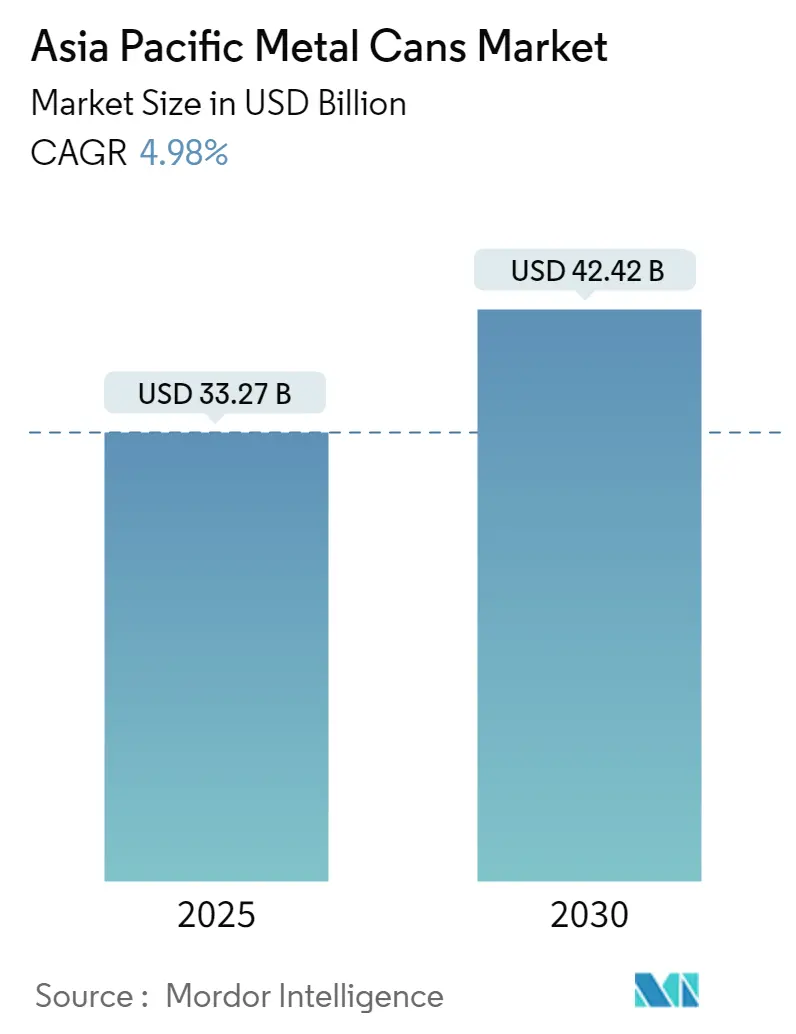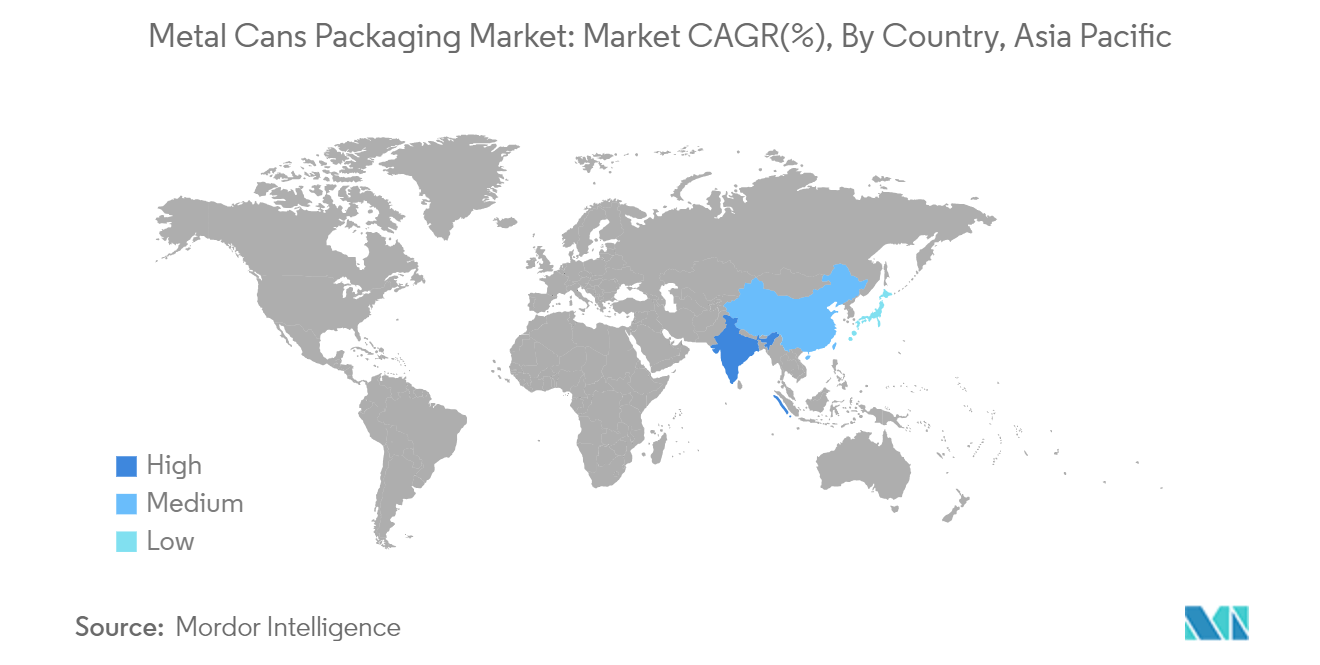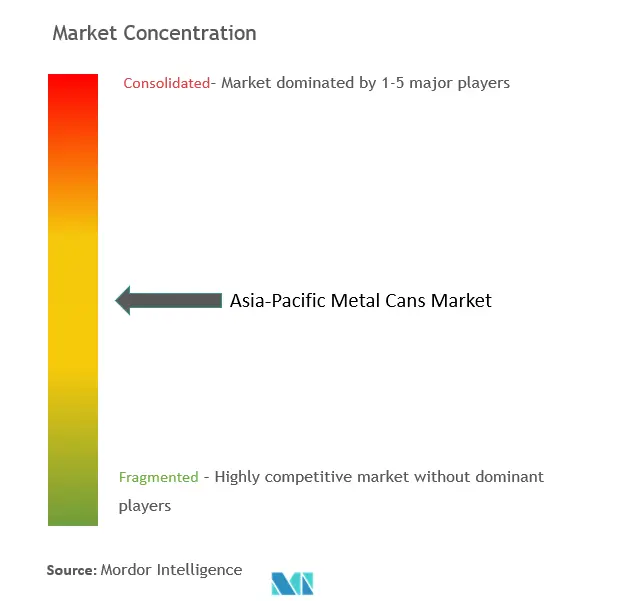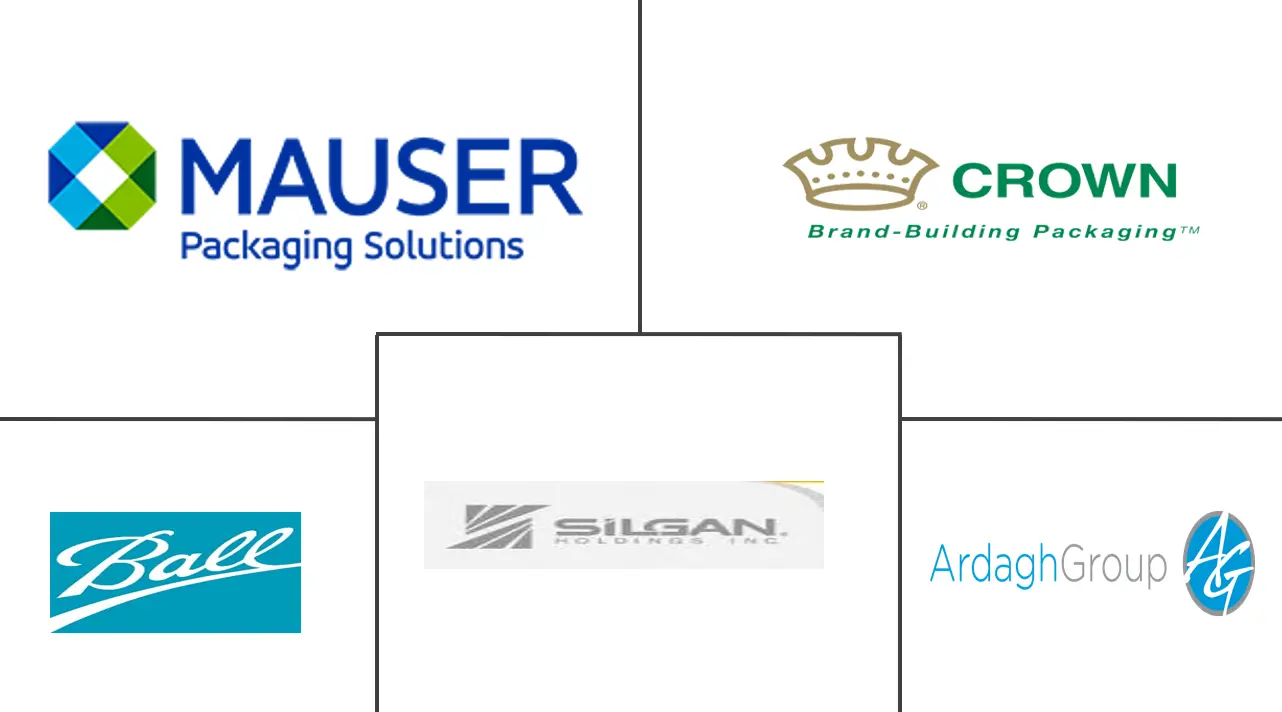
Asia Pacific Metal Cans Market Analysis by Mordor Intelligence
The Asia Pacific Metal Cans Market size is worth USD 33.27 Billion in 2025, growing at an 4.98% CAGR and is forecast to hit USD 42.42 Billion by 2030.
- The metal cans market is witnessing a paradigm shift fueled by a severe search for innovation and sustainability. Manufacturers increasingly adopt cutting-edge materials and eco-friendly practices, aligning with the global push for environmentally responsible packaging solutions.
- Cans are easy to carry and light in weight, making them ideal for consumers. Additionally, using cans helps minimize the risk of spills or breakage, making them especially popular for outdoor activities and events. The increasing consumer preference for canned drinks, the rising popularity of energy and sports drinks, and the growing demand for sustainable packaging materials are some of the critical drivers of the market.
- Concerns about plastic waste in various Asia-Pacific countries will likely be one of the growth factors for metal packaging during the forecast period. Manufacturers and consumers now prioritize other considerations, such as low cost and convenience. However, the future expansion of metal packaging may be aided by increased government initiatives to regulate and decrease packaging waste.
- Across Asia, the food packaging industry increasingly relies on metal cans due to their ideal preservative properties and structural integrity, which extend shelf life. Packaged and convenient foods have become dietary staples as consumers juggle hectic lifestyles and work schedules.
- Trends like a preference for smaller and multi-pack formats are driving the growth of the metal cans market. There is a rising demand for mini-cans in the Asia-Pacific markets, including India, China, and Japan. In response, many regional beverage companies are introducing mini-cans, which offer smaller volumes at a lower cost than traditional cans.
- Asian trends are intertwined with the growth of Southeast Asia. Manufacturers from China and Japan are broadening their presence in the region. For instance, Showa Aluminum Can Corporation, through its project, is strategically targeting Southeast Asia for medium-term business growth.
- Innovations in manufacturing processes, diverse shapes and sizes, and advancements in smart packaging are enabling metal can manufacturers to stay aligned with market trends. Clean surfaces that accommodate multi-stage printing and labeling are drawing significant marketing innovations.
- As an illustration, Hindustan Tin Works Ltd from India produces general line cans that offer superior barriers against oxygen, moisture, and bacteria and deter rodents and pests, ensuring product safety until consumption.
- Metal cans, especially aluminum, lead the way in recycling. Their ability to be recycled without any loss of quality at the end of their life cycle makes them the preferred choice for packaging for brands, surpassing alternatives such as plastic and paper. This swift return to shelves as new cans in 60 days underscores aluminum's appeal in the food, beverage, and aerosol industries.
- However, metal cans grapple with stiff competition from alternative packaging solutions. Plastic packaging, especially in forms like bottles and pails, stands as the primary competitor. Additionally, the emergence of polymer-based substitutes and fluctuating raw material prices pose challenges for the metal cans market in the region.
Asia Pacific Metal Cans Market Trends and Insights
Convenience and Lower Price Offered by Canned Food to Drive the Market Growth
- The canned food market is seeing a rise in innovative packaging due to the growing demand for chemical-free options. Many brands of canned food products have started offering food in BPA-free containers.
- The demand for sealed and tamper-proof steel container food is high, as they protect food from harmful bacteria. Also, due to consumers' busy lifestyles, canned food is expected to gain more importance.
- Pet food packaging can significantly influence the quality and safety of the food product by providing barriers to moisture and other environmental conditions that may result in contamination and spoilage. Metal is commonly used in pet food packaging, typically tin or aluminum, and is tightly sealed to prevent any food, odors, or leaks from escaping.
- Limited design flexibility and inconvenience in opening the cans have been the significant disadvantages of metal pet food cans. This segment is trying to increase its competitiveness by emphasizing steel cans' safety and environmental friendliness, owing to their recyclability and use of recycled content. Pet food packaged in metal cans is preferred over plastic alternatives due to cans' tight seal and tamper evidence.
- Other advantages include its low cost, long shelf life, durability, and amenability to wet food products. Additionally, easy opening ends are expected to support continued opportunities. Fast-filling speeds and line efficiencies of metal food cans also make manufacturers reluctant to shift production to plastic alternatives, which are slower to manufacture and involve added production costs.

India to Witness Significant Growth
- In recent years, the Indian beverage industry has seen a significant shift in juice packaging. This evolution goes beyond merely following trends; it reflects changing consumer preferences and a growing awareness of environmental issues. In light of this, manufacturers are prioritizing sustainable product launches in India.
- In 2024, Ball Corporation partnered with Del Monte Foods, a global leader in innovative, sustainable aluminum packaging. Both companies are committed to sustainability, aligning with the Indian government's ambitious goals of achieving net-zero emissions by 2070 and cutting carbon intensity by 45% by 2030. With Ball's backing, Del Monte Foods moved from traditional three-piece tin cans to infinitely recyclable two-piece aluminum beverage cans.
- Additionally, the recent regulation on the ban on single-use plastics is expected to grow plastic packaging growth, which is scheduled to be enforced once the discussion with all the stakeholders is concluded. The Food Safety and Standards Authority of India is reviewing the ban on using single-use plastic materials to accommodate eco-friendly alternatives.
- With the growth of the alcoholic and non-alcoholic beverage market, the demand for metal can packages is expected to increase significantly in the country. For instance, according to the Craft Brewers Association of India, the number of microbreweries in India galloped from 20 to 120 in the past five years.
- The Aluminum Beverage Can Association of India (ABCAI) consortium is pushing for a shift from plastic and glass packaging to aluminum. Aluminum cans hold a mere 5% share of the country's packaging landscape, but ABCAI aims to elevate this figure to approximately 25% by 2030.
- Also, the Ministry of Mines data reveals that primary aluminum production rose from 40.73 lakh tons (LT) in FY 2022-2023 to 41.59 LT in FY 2023-2024, marking a growth rate of 2.1%. This increase in aluminum production signals a burgeoning demand for metal cans. Given that producing metal cans heavily relies on aluminum, the increased production volume indicates that manufacturers are ramping up metal can production to cater to this surging consumer appetite.
- Moreover, the proliferation in the beer market by newer companies in the country is helping the Indian metal can segment. Ball Corporations also provide metal cans that meet the requirement of beverage products, with an annual capacity of 1.3 billion cans in India. According to the Ball Corporation, the consumption in India is less than one can per capita, which presents a massive opportunity for metal packaging providers to tap into the emerging market.
- Also, collaborations between beverage companies and can manufacturers in India fuel the growth of the metal cans market. For example, in 2024, United Breweries of India, a subsidiary of HEINEKEN, partnered with CANPACK to unveil a limited-edition beer prominently featuring a feminine theme. This new premium lager, dubbed 'Queenfisher', is designed to complement the company's flagship 'Kingfisher' brand.

Competitive Landscape
The Asia-Pacific metal cans market is fragmented and consists of a diverse array of key players, including Ball Corporation, Crown Holdings, Ardagh Group SA, Silgan Holdings Inc., and Mauser Packaging Solution. These companies actively focus on business expansion in the metal cans market through innovations, collaborations, and mergers and acquisitions.
May 2024: As a major move toward sustainable packaging, Ball Corporation teamed up with CavinKare, a trailblazer in the dairy industry. The collaboration aims to transform dairy packaging by rolling out retort two-piece aluminum cans for CavinKare’s renowned milkshakes.
The dairy and dairy alternatives segment is pivotal in India and is projected to expand at an annual growth rate of 4.1% by 2028, as per company projections. The company concentrates on the ready-to-drink segment, anticipating quicker growth by diverse flavor offerings. Ball India has bolstered its capabilities to manufacture retort aluminum cans specifically designed for the dairy sector's needs. This portfolio expansion emphasizes the commitment to product innovation and sustainability and facilitates the packaging a diverse range of flavored dairy products in aluminum cans.
July 2023: Crown Holdings announced it would join the schedule of speakers at Asia CanTech 2023, which will be held in Bangkok, Thailand, from October 30 to November 1. The business will discuss the study's findings on the recycling rates of aluminum beverage cans, including Thailand, Vietnam, and Cambodia.
Asia Pacific Metal Cans Industry Leaders
-
Ball Corporation
-
Crown Holdings
-
Ardagh Group SA
-
Silgan Holdings Inc.
-
Mauser Packaging Solution
- *Disclaimer: Major Players sorted in no particular order

Recent Industry Developments
- March 2024: Toyo Seikan Co. Ltd (“Toyo Seikan”), a subsidiary of Toyo Seikan Group Holdings Ltd, introduced the lightest aluminum DI can in the domestic market, specifically designed for 204 mm SOT (stay-on tab) cans. By employing compression bottom reform (CBR) technology, Toyo Seikan has reinforced the bottom of the beverage can, allowing for a reduction in its overall weight. This innovation is anticipated to curtail greenhouse gas (GHG) emissions. From April 2024, Toyo Seikan has commenced mass production of 350 ml and 500 ml cans at its Chitose and Kiyama factories, with plans to expand to other factories nationwide.
- July 2024: Ball Beverage Packaging Limited, a company that supplies aluminum cans to the beer, soft drink, and perfume industries, established a production unit in Telangana, India, with an investment of INR 700 crore (USD 83.37 million).
Asia Pacific Metal Cans Market Report Scope
Metal cans are containers predominantly crafted from metal, designed to hold and preserve a range of items, from food and beverages to other substances. This study monitors the demand for metal cans in Asia-Pacific, measuring the value (USD million) generated from sales by diverse vendors.
The Asia-Pacific metal cans market is segmented by material type (aluminum and steel), product type (2-piece and 3-piece), can type (food cans (vegetables, fruits, pet food, soups, coffee, and other food cans), beverage cans (alcoholic and non-alcoholic), aerosol cans (cosmetics and personal care, household, paints and varnishes, pharmaceutical/veterinary, automotive/industrial, and others aerosol cans)), and Country (India, China, South Korea, Japan, Australia and New Zealand, and Rest of Asia-Pacific). The report offers market forecasts and size in value (USD) for all the above segments.
| Aluminium |
| Steel |
| 2-piece |
| 3-piece |
| Food Cans** | Vegetables |
| Fruits | |
| Pet Food | |
| Soups | |
| Coffee | |
| Other Food Cans | |
| Beverages Cans | Alcoholic |
| Non-alcoholic | |
| Aerosol Cans** | Cosmetics and Personal Care |
| Household | |
| Paints and Varnishes | |
| Pharmaceutical/Veterinary | |
| Automotive/Industrial | |
| Other Aerosol Cans | |
| Other Cans Types |
| India |
| China |
| South Korea |
| Japan |
| Australia and New Zealand |
| Material Type | Aluminium | |
| Steel | ||
| Product Type | 2-piece | |
| 3-piece | ||
| Can Type | Food Cans** | Vegetables |
| Fruits | ||
| Pet Food | ||
| Soups | ||
| Coffee | ||
| Other Food Cans | ||
| Beverages Cans | Alcoholic | |
| Non-alcoholic | ||
| Aerosol Cans** | Cosmetics and Personal Care | |
| Household | ||
| Paints and Varnishes | ||
| Pharmaceutical/Veterinary | ||
| Automotive/Industrial | ||
| Other Aerosol Cans | ||
| Other Cans Types | ||
| Country | India | |
| China | ||
| South Korea | ||
| Japan | ||
| Australia and New Zealand | ||
Key Questions Answered in the Report
How big is the Asia Pacific Metal Cans Market?
The Asia Pacific Metal Cans Market size is worth USD 33.27 billion in 2025, growing at an 4.98% CAGR and is forecast to hit USD 42.42 billion by 2030.
What is the current Asia Pacific Metal Cans Market size?
In 2025, the Asia Pacific Metal Cans Market size is expected to reach USD 33.27 billion.
Who are the key players in Asia Pacific Metal Cans Market?
Ball Corporation, Crown Holdings, Ardagh Group SA, Silgan Holdings Inc. and Mauser Packaging Solution are the major companies operating in the Asia Pacific Metal Cans Market.
What years does this Asia Pacific Metal Cans Market cover, and what was the market size in 2024?
In 2024, the Asia Pacific Metal Cans Market size was estimated at USD 31.61 billion. The report covers the Asia Pacific Metal Cans Market historical market size for years: 2019, 2020, 2021, 2022, 2023 and 2024. The report also forecasts the Asia Pacific Metal Cans Market size for years: 2025, 2026, 2027, 2028, 2029 and 2030.
Page last updated on:
Asia Pacific Metal Cans Market Report
Statistics for the 2025 Asia Pacific Metal Cans market share, size and revenue growth rate, created by Mordor Intelligence™ Industry Reports. Asia Pacific Metal Cans analysis includes a market forecast outlook for 2025 to 2030 and historical overview. Get a sample of this industry analysis as a free report PDF download.



